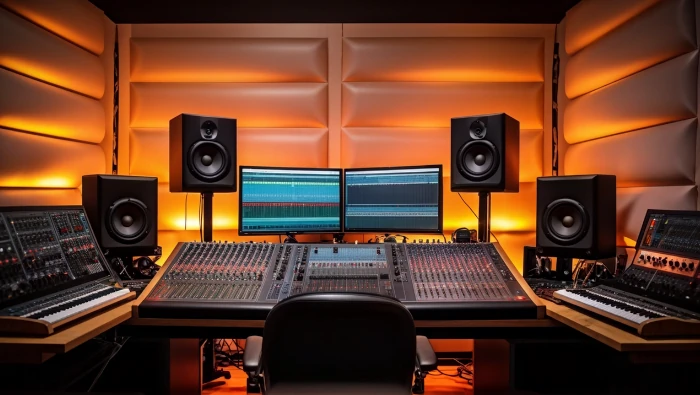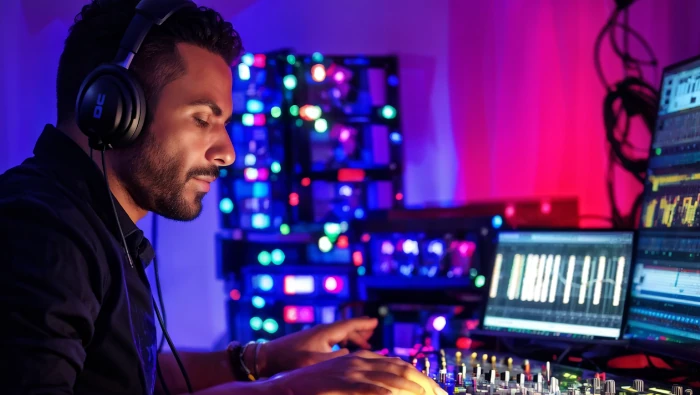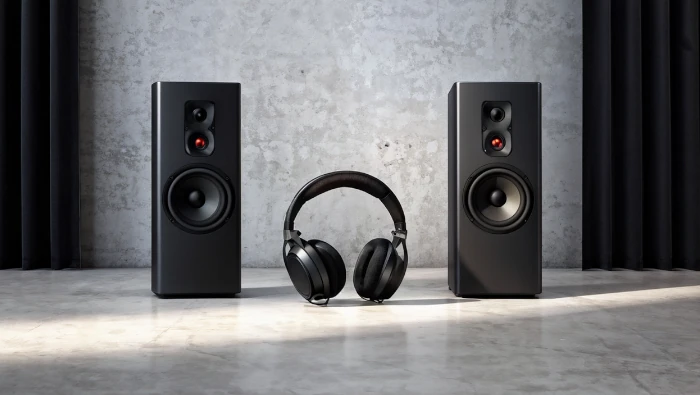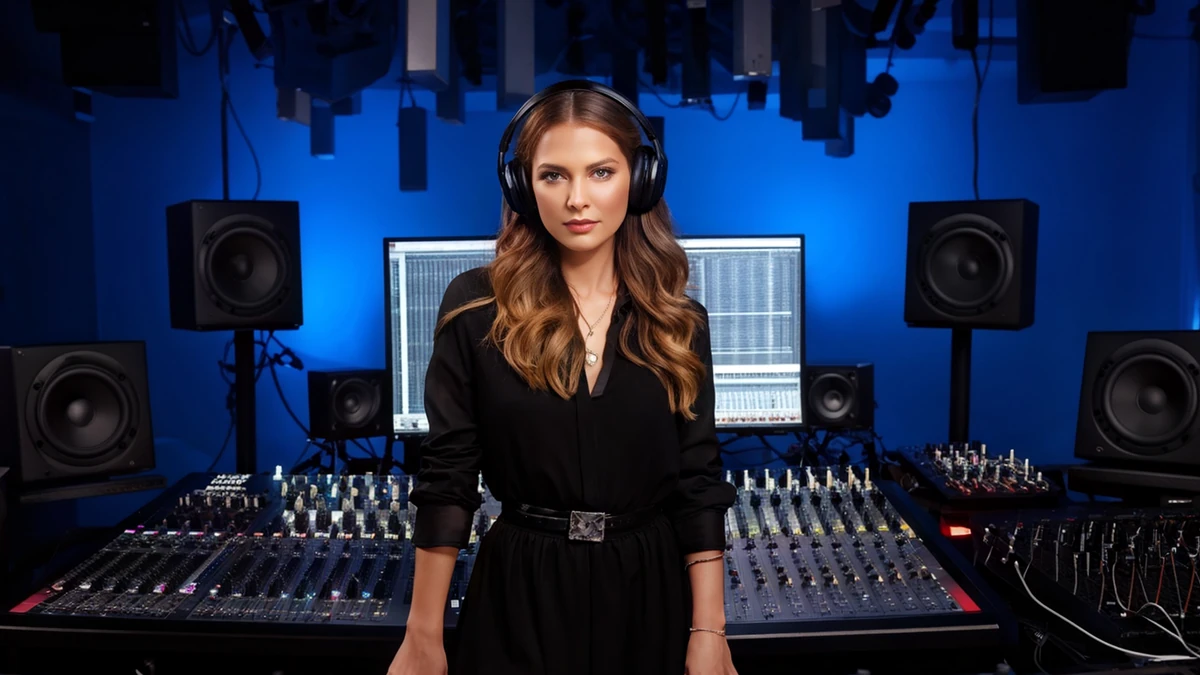Table of Contents
- Studio Monitors: The Backbone of Professional Studios
- Headphones: The Portable Solution
- When to Use Studio Monitors
- When to Use Headphones
- Conclusion: Finding the Balance
Choosing between studio monitors and headphones is a common dilemma for music producers. Both tools are essential in a studio setting, each offering unique advantages that cater to different aspects of music production. Studio monitors are renowned for their accurate sound representation, providing a flat frequency response that reveals the true nature of a recording. On the other hand, headphones offer unparalleled portability and isolation, making them ideal for detailed editing and on-the-go production.
Understanding the strengths and weaknesses of each can help you make an informed decision. Whether you’re mixing and mastering tracks or working late at night without disturbing others, the right choice can significantly impact the quality of your work. In this blog post, we will explore the benefits and drawbacks of studio monitors and headphones, guiding you on when to use each tool for optimal results in your music production journey.
Studio Monitors: The Backbone of Professional Studios

Studio monitors are the cornerstone of any professional music studio. Unlike regular speakers, studio monitors are designed to provide a flat frequency response, ensuring that what you hear is the most accurate representation of your audio. This accuracy is essential for mixing and mastering, as it allows you to make precise adjustments to your tracks.
One of the key benefits of studio monitors is their ability to reveal the true sound of a recording. Regular speakers often color the sound, adding bass or treble to make music more enjoyable for casual listening. In contrast, studio monitors present the sound exactly as it is, which is crucial for identifying any issues in the mix.
Studio monitors also excel in creating a more realistic soundstage. They help you understand how your music will sound in different environments, from car stereos to high-end audio systems. This broad perspective is invaluable when aiming for a mix that translates well across all playback systems.
However, using studio monitors requires a well-treated room. Poor room acoustics can color the sound, defeating the purpose of having accurate monitors. Acoustic treatment, such as bass traps and diffusers, can significantly enhance the performance of your monitors by minimizing reflections and standing waves.
When setting up a home studio, ensuring optimal sound is crucial. Learn how to improve the audio quality of your home studio with these tips.
In summary, studio monitors are an indispensable tool for any serious music producer. They offer unparalleled accuracy and insight into your audio, making them the preferred choice for critical listening tasks. With the right setup and room treatment, studio monitors can elevate the quality of your productions, helping you achieve professional-sounding mixes.
Headphones: The Portable Solution

Headphones are an essential tool for music producers, offering unique advantages that complement studio monitors. They are perfect for scenarios where portability and isolation are paramount. With a good pair of studio headphones, you can achieve high-quality sound without being confined to a specific location.
One of the biggest benefits of headphones is their portability. Whether you’re traveling, working in a café, or just moving between rooms in your home, headphones allow you to continue producing without interruption. This flexibility is invaluable for producers who need to work on the go or in environments where setting up studio monitors is impractical.
Another advantage of headphones is their ability to provide excellent noise isolation. This isolation allows you to focus on the details of your mix without being affected by external sounds. It’s especially useful in environments where external noise is an issue, such as in shared living spaces or noisy surroundings. Headphones also prevent your music from disturbing others, making them ideal for late-night sessions or working in quiet environments.
However, headphones do have their limitations. Extended use can lead to ear fatigue, and they might not provide the same spatial awareness as studio monitors. The soundstage in headphones is often more limited, which can make it harder to judge the placement of instruments in a mix.
Interested in recording audio on the go? Check out how to record high-quality audio on a laptop.
Despite these drawbacks, headphones are indispensable for certain tasks. They excel in detailed editing and allow you to catch subtle nuances in your tracks that might be missed on monitors. For critical listening and precision tasks, a high-quality pair of studio headphones can be a game-changer.
In conclusion, headphones offer a portable and isolated solution for music production. While they might not replace studio monitors, they provide a valuable complement, enabling producers to work flexibly and with precision in various environments.
When to Use Studio Monitors
Studio monitors are essential tools for specific stages of the music production process. Their primary advantage lies in their ability to deliver a flat frequency response, which provides an uncolored and accurate representation of your audio. This makes them indispensable for mixing and mastering tasks.
Mixing: When you’re mixing a track, you need to hear every detail clearly and accurately. Studio monitors excel at revealing the true balance of your mix, allowing you to make precise adjustments. The flat frequency response ensures that no part of the audio spectrum is artificially enhanced or diminished, helping you achieve a balanced mix that translates well across different playback systems.
Mastering: Mastering is the final step of music production, where the track is polished and prepared for distribution. This process requires the utmost accuracy, as even the slightest mistake can affect the final product. Studio monitors provide the clarity and detail needed to make subtle enhancements and ensure the track sounds professional.
Critical Listening: For producers who are serious about their craft, critical listening sessions are crucial. This involves analyzing the finer details of a recording, such as reverb tails, panning, and instrument separation. Studio monitors help you identify and address any issues, ensuring your track is of the highest quality.
Sound Design: When creating and tweaking sounds, it’s important to hear them in their purest form. Studio monitors allow sound designers to craft detailed and complex sounds that maintain their integrity when played back on various systems.
However, to get the most out of your studio monitors, you need a well-treated room. Room acoustics play a significant role in how monitors perform, and untreated rooms can introduce reflections and standing waves that color the sound. Acoustic treatment, such as bass traps and diffusers, helps create a more accurate listening environment.
Discover the importance of studio monitors in creating a musical arrangement that sounds professional.
In summary, studio monitors are best used for tasks that require precision and accuracy, such as mixing, mastering, critical listening, and sound design. Investing in quality monitors and properly treating your room can significantly enhance the quality of your music production.
When to Use Headphones
Headphones play a crucial role in the music production process, particularly in situations where studio monitors might not be practical or effective. They offer unique benefits that make them indispensable for certain tasks.
Detailed Editing: Headphones are ideal for detailed editing tasks. Their ability to isolate sound helps you focus on intricate details such as removing clicks, adjusting fades, or correcting timing issues. This level of precision can be challenging to achieve with studio monitors, especially in less-than-perfect acoustic environments.
Late-Night Sessions: If you need to work late at night or in a shared living space, headphones are the perfect solution. They allow you to produce music without disturbing others, making it possible to work at any hour. This flexibility is particularly beneficial for producers who have irregular schedules or live in apartments.
Portable Production: For producers who are always on the go, headphones are indispensable. They enable you to continue working on your projects whether you’re traveling, in a coffee shop, or simply away from your home studio. This portability ensures that you can maintain your workflow and productivity regardless of your location.
Noise Isolation: In environments where external noise is an issue, headphones provide excellent isolation. This makes them perfect for monitoring live recordings or working in noisy settings. The isolation allows you to focus on your music without being distracted by surrounding sounds.
A/B Testing: Comparing your mix on multiple playback systems is essential to ensure it translates well. Headphones provide a different perspective on your mix, helping you identify issues that might not be apparent on studio monitors. This practice, known as A/B testing, is crucial for achieving a balanced mix.
For vocal recording tips that work well with headphones, read 5 tips to record vocals in your home studio.
Despite their advantages, it’s important to be aware of the limitations of headphones. Extended use can lead to ear fatigue, and their soundstage is typically more limited compared to studio monitors. This can make it harder to judge spatial elements in your mix. Additionally, the frequency response of headphones can vary widely, so it’s crucial to use high-quality, flat-response models for critical listening.
In conclusion, headphones are best used for detailed editing, late-night sessions, portable production, noise isolation, and A/B testing. They complement studio monitors by providing a different listening perspective and allowing for flexible and precise work in various environments.
Conclusion: Finding the Balance

Choosing between studio monitors and headphones isn’t about selecting one over the other; it’s about understanding how each tool fits into your music production workflow. Both have their strengths and unique advantages that can enhance your work in different scenarios.
Studio Monitors: These are indispensable for tasks that require accuracy and a true representation of your audio. When mixing and mastering, studio monitors provide the clarity and detail necessary to make precise adjustments. They help you create a mix that translates well across various playback systems. However, they require a well-treated room to deliver optimal performance, making them best suited for stationary studio setups.
Headphones: Offering portability and isolation, headphones are perfect for detailed editing, late-night sessions, and work on the go. They allow you to produce music without disturbing others and provide excellent noise isolation in noisy environments. While they might not offer the same spatial awareness as monitors, high-quality headphones are crucial for critical listening and A/B testing.
The key to successful music production is finding a balance between the two. By understanding when to use each tool, you can leverage their strengths to enhance your workflow. Many producers find that using both studio monitors and headphones provides the best results. Monitors give you an accurate soundstage and overall mix perspective, while headphones allow for detailed work and flexibility.
To enhance your recording setup, consider how to produce a song without leaving home.
In conclusion, integrating both studio monitors and headphones into your production process can elevate the quality of your work. They complement each other, ensuring you have the right tools for every stage of music production. Experiment with both to discover what works best for your specific needs and environment, and you’ll be well on your way to creating professional-sounding tracks. For further insights and professional reviews on audio equipment, check out Sound on Sound, a trusted resource for audio professionals.

